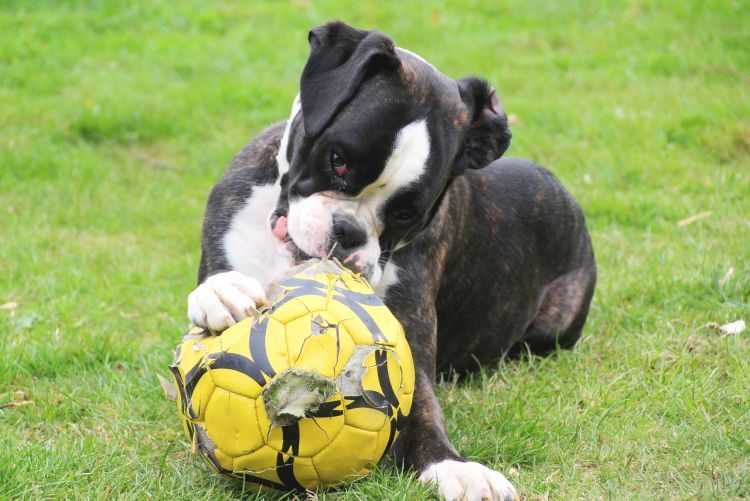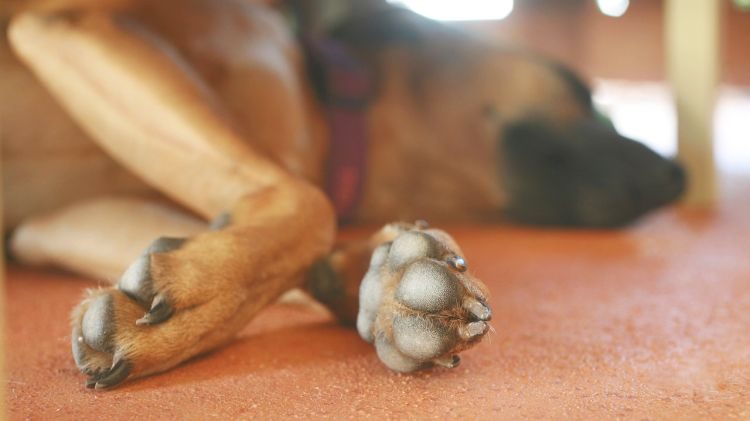
Have you ever had cracked heels?
Sore, aren’t they? Deep fissures on your heels that open up with every step make it feel like walking on glass shards.
I’m guessing (because dogs can’t speak) this is what it feels like for dogs with severe crusty pads. If your dog suffers from this, you’ll know exactly what I mean.
Dry, Cracked Paws in Dogs
Crusty pads are those that, instead of being smooth and supple, are greatly thickened and hard.
Not only that, but the tissue also sheers vertically, sometimes forming fronds or feathers, and sometimes crumbly bits.
If the dog is really unlucky, the thickened foot pads fissure, causing deep cracks like the ones on our dry heels.
But, unlike people — where cracked heels are often due to hardworking feet — in dogs, the causes are different.
Nasodigital Hyperkeratosis
Personally, I like the terms “crusty noses” and “crusty footpads.”
But there’s also a technical term for this condition: nasodigital hyperkeratosis.
This more intimidating term also means crusty noses and feet, but in a fancy way. Let’s break it down:
- naso = nose
- digital = pads
- hyper = too much
- keratosis = keratin in the skin
So what causes nasodigital hyperkeratosis in dogs?
Actually, this is a trick question because no one knows. That said, some breeds are more likely to be affected than others, such as:
You will recognize the problem right away, especially on the nose. That black, leathery button takes on a dry, cracked, cobbled-street appearance.
This is most likely due to nasodigital hyperkeratosis, but on rare occasions, it may be a complication of an underlying health condition.

How We Treat Nasodigital Hyperkeratosis in Dogs
Just as with our own cracked heels, there’s no magic pill that makes nasodigital hyperkeratosis in dogs go away.
Instead, the answer is moisturizing — and lots of it. However, your veterinarian may first want to run tests to check that there’s no underlying health problem.
- Start by soaking the foot for 10 minutes in a wet compress. This is as simple as soaking cotton wool in water, squeezing most of the moisture out and applying the damp wool to the paw. The idea is the water soaks into the dry keratin, making it more supple.
- It can be a struggle to keep the cotton wool in place. One tip is to pop baby socks over the cotton wool to hold it in place. (Great for paws, not so great for noses.) Get into the habit of doing this when watching TV, when the dog is relaxed.
- After the soaking, apply a generous lashing of a human emollient cream or balm. Just be sure it’s OK if the dog licks it off, and avoid any ointments containing zinc. Also, watch out for the dog leaving sticky paws prints wherever they go. Applying the balm before bedtime can help.
- Do this daily for 7–10 days, then every other day after that.
Underlying Conditions
So what other conditions might cause nasodigital hyperkeratosis in dogs?
Was YOUR Pet Food Recalled?
Check Now: Blue Buffalo • Science Diet • Purina • Wellness • 4health • Canine Carry Outs • Friskies • Taste of the Wild • See 200+ more brands…

1. Ichthyosis
This looks a lot like nasodigital hyperkeratosis but comes with other symptoms attached. It’s caused by a mutation of the gene that controls keratin production (including hair, as well as dog noses and foot pads).
Dogs with ichthyosis may suffer from add-on issues, such as lack of tear production, a frizzy coat and patches of excessively dry skin.
The breeds most likely to have ichthyosis include:
- Cavalier King Charles Spaniels
- American Bulldogs
- Labrador Retrievers
- Boston Terriers
- Great Danes
- Irish Setters
Sadly, there is no cure. Treatment is aimed at just moisturizing the very dry skin.

2. Zinc Deficiency
Arctic dog breeds, such as Huskies and Malamutes, head the list for this problem.
Symptoms of zinc deficiency include:
- Crusty paws and nose
- A dry, dull coat
- Stunted growth
- Skin scaling, especially around the eyes and lips
The cause is a reduced ability to soak up zinc present in food.
When you feed your dog a well-balanced diet, this shouldn’t cause a problem. But you feed a poor or restricted diet, then this, coupled with difficulty absorbing zinc, can lead to signs of deficiency.
Fortunately, these dogs usually respond well to an improved diet or giving a simple dietary supplement containing zinc.
3. Pemphigus
Pemphigus is an autoimmune disease where the body’s immune system attacks the places where keratin meets furry skin. This can result in inflammation, irritation, scaling and ulcers.
Most commonly, this is an erosive condition, meaning it eats into the skin. But the crusts and scabs that form to plug the ulcers can sometimes be mistaken for a weird type of nasodigital hyperkeratosis.
Treatment targets switching off the inappropriate immune response to settle down the attack on the skin.
4. Distemper
The old name for distemper is “hard pad.”
This is because one of the late onset signs of distemper is nasodigital hyperkeratosis. Those hard pads make a distinct clicking sound when the dog walks on a firm floor.
Again, there’s no cure for this symptom except keeping those feet moisturized.
This Frenchie might just have his moisturizing balm for dinner:

Help for Nasodigital Hyperkeratosis in Dogs
Crusty noses or paws can be sore.
With noses, get the dog checked by a vet. But if the crusty nose is purely cosmetic, then know that pet-safe moisturizing balms or creams are a dog’s best friend.
Here’s to wet noses — for all the right reasons!
 This pet health content was written by a veterinarian, Dr. Pippa Elliott, BVMS, MRCVS. It was last reviewed July 20, 2018.
This pet health content was written by a veterinarian, Dr. Pippa Elliott, BVMS, MRCVS. It was last reviewed July 20, 2018. 

